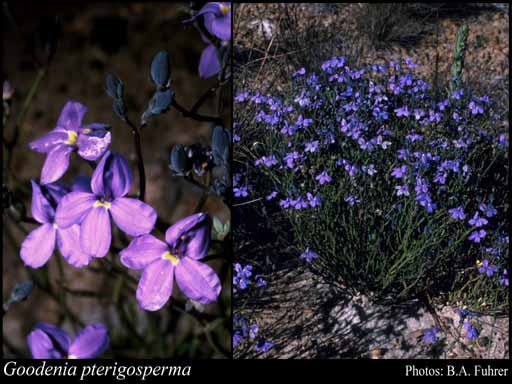- Reference
- Prodr. 578 (1810)
- Conservation Code
- Not threatened
- Naturalised Status
- Native to Western Australia
- Name Status
- Current
Erect to sprawling perennial, herb or shrub, 0.2-0.4 m high. Fl. blue-purple, Sep to Dec or Jan. Sandy soils.

Scientific Description
Stems ribbed. Leaves flat, 20-90 mm long, 2-7 mm wide, Indumentum absent (leaves glabrous); margins entire or toothed. Bracteoles present, 1.8-2.5 mm long, glabrous. Pedicel pedicellate, Pedicel length the pedicels 10-25 mm long, glabrous. Calyx lobes present, Calyx length 2-3.5 mm long, glabrous. Corolla blue, 12-15 mm long, without auricles, not spurred, glabrous on the outside, glabrous on the inside; central lobes 5.5-7 mm long, with wings; outer lobes 8-10 mm long, wing present on both sides and clearly unequal, 1-1.2 mm wide on the narrower side, 1.8-2 mm wide on the broader side. Anthers free. Ovary inferior, not gibbose; style 7.5-8 mm long, hairy; indusium single, hairy; ovules more than two. Flowers in January, September, October, November and December. Occurs in the Coolgardie (COO), Jarrah Forest (JF), Mallee (MAL) and Esperance Plains (ESP) IBRA Region(s), of the Eremaean (E) and South West (SW) Botanical Province.
Distribution
- IBRA Regions
- Coolgardie, Esperance Plains, Jarrah Forest, Mallee.
- IBRA Subregions
- Eastern Mallee, Fitzgerald, Mardabilla, Recherche, Southern Jarrah Forest, Western Mallee.
- IMCRA Regions
- WA South Coast.
- Local Government Areas (LGAs)
- Albany, Cranbrook, Esperance, Gnowangerup, Jerramungup, Kojonup, Lake Grace, Plantagenet, Ravensthorpe.